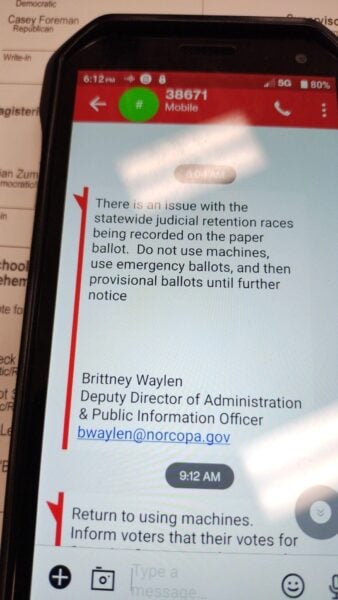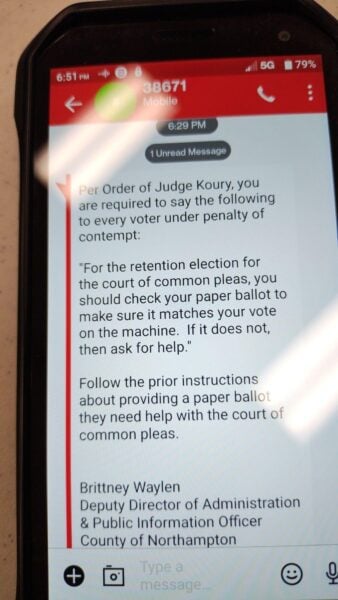“Vote flipping” is a term that, unfortunately, has become too familiar over the last several years. In the 2020 Presidential Election, Antrim County, MI infamously flipped votes to award the county to Joe Biden. It was caught and follow-up count “flipped” the county back to President Trump. However, three more counts took place and, in the end, all five counts all had different results (the last two counts were different in the US Senate race).
In 2022, there was the infamous DeKalb County “flip” that saw a Democrat County Commission go from worst to first after she saw “0” votes for her in the district she voted for herself in. This flip was eerily similar to Antrim County and used the same voting machine manufacturer.
Another “flip” occurred in 2022. This issue was in Cherokee County, KS, where they use ES&S DS200 and ExpressVote machines with KnowInk poll pads, according to Verified Voting. During this primary election, a County Commission race was luckily the one county race pulled for an audit. Otherwise, the incorrect winner would have been certified.
And now, 2023:
During Tuesday’s election in Northampton County, Pennsylvania, ran into hot water for the second time in four years. In 2019, the county had a formatting issue that required the use of paper ballots, according to ABC News.
This time, the ES&S ExpressVoteXL flipped votes on a PA Superior Court retention question for two judges: Judge Jack Panella and Victor P. Stabile. According to a Judge of Election in one of the precincts, the third retention race for Judge Jennifer R. Sletvold was not effected by the “glitch”. If a voter voted all three as “yes” or all three as “no”, the printed ballot accurately represented what was on the selection screen. However, if a voter voted “yes” and “no” in either combination for the two judges, they would be reversed on the ballot when it printed.
The issue was originally reported as a “coding error” by the ABC27. However, The the Vice President of Customer Operations for ES&S reported it as a “human error based on someone from our team that programmed the election and they made a mistake putting the printed text on the card as compared to the vote screen.”
VP of Customer Operations of Voting Machine Company that ‘Flipped’ Votes Says “It Was a Human Error Someone From Our Team Programmed the Election”
Thanks to an X Space hosted by AZ People’s Alliance’s Jeannette Garcia and attorney Stefanie Lambert of Michigan, we had some insight from a local Judge of Election (the Head Poll Worker) in Northampton. She joined the conversation via Lambert to tell her story and field questions.
She began by stating that the issue persisted the entire day. Several advisories were given to poll workers from three different Judges throughout the day. The advisories were sent via county-distributed cell phones that were in each precinct. The precinct this woman worked at had begun issuing provisional/emergency ballots to voters, despite not having the secrecy envelopes for each.
“When you look at the press conference from our county executives, they have such a soothing and calming effect. But that is not, in fact, the reality that was going on in the polling stations,” she said. “It was the complete opposite.”
At approximately 8:04am, the first advisory text message was sent out to the county phones from the Deputy Director of Administration & Public Information Officer (all ensuing texts are from this same individual):
“There is an issue with the statewide judicial retention races being recorded on the paper ballot. Do not use machines, use emergency ballots, and then provisional ballots until further notice.”
This was going to be a problem for the poll worker’s precinct as they were already beginning to run low on emergency and provisional ballots.
Thankfully, at 9:12am, she texted out:
“Return to using machines. Inform voters that their votes for Superior Court retention question will show up in reverse but will be counted correctly.“
At 11:14am, a text was sent saying:
“Judge Abraham P. Kassis has ordered that you are to instruct voters before the voter enters the voting booth that there is an issue with the recording of their vote for the candidates for retention to the Pennsylvania Superior Court, that the paper receipt will record their selection for retention to the Pennsylvania Superior Court one candidate to the other candidate.“
That message is incredibly difficult to fully understand.
At 12:10pm, another text stated:
“Based on a Dept. of State suggestion, we are advising you to make clear that voters should vote how they intend to on the screen.”
At 4:40pm, an Order from Judge Murray (believed to be Judge Samuel P. Murray) was texted out:
“Per Order of Judge Murray, Poll Workers are instructed to advise voters the following:
‘Voters are advised to check the paper receipts to be sure that it properly reflects their intended vote. If it does not, then the voter shall ask for help from a poll worker. In such cases, in precincts with one voting machine, the voter will immediately be offered an emergency paper ballot at the voting site and their electronic vote shall be cancelled.
In precincts with multiple voting machines, the voter will be offered to vote on another machine and their original vote shall be cancelled.
If any problem occurs, the voter will immediately be offered an emergency paper ballot at the site and any electronic vote shall be cancelled.”

At 6:29pm, another Order was texted out:
“Per Order of Judge Koury (believed to be Judge Michael J. Koury), you are required to say the following to every voter under penalty of contempt:
‘For the retention election for the court of common pleas, you should check your paper ballot to make sure it matches your vote on the machine. If it does not, then ask for help.’
Follow the prior instructions about providing a paper ballot [sic] they need help with the court of common pleas.”
So to recap:
- Poll workers were first told not to use machines (8:04am)
- Then, use machines, but their vote will “show up in reverse but counted correctly” (counted correctly from the screen or the paper ballot?)
- Judge Kassis’s Order states “that the paper receipt will record their selection” (11:14am)
- But at 12:10pm, the Dept. of State advised that “voters should vote how they intend to on the screen.” (12:10pm)
- In another flip, Judge Murray’s Order states “Voters are advised to check the paper receipt to be sure it properly reflects their intended vote.” (4:40pm)
- The last order for the Court of Common Pleas has not been reported as being affected by this “human error”.
Assuming that the remedy for the crisis improved over the course of the day, the initial advise given “that the paper receipt will record their selection” at 11:14am varied from the subsequent advisory that came out an hour later, which varied from the Order that came out four hours after the last.
- Which advisory was correct and how many voters were disenfranchised by incorrect advise?
- How many voters were turned away because precincts ran out of emergency/provisional ballots? Why didn’t precincts have secrecy envelopes?
- How can this debacle ever be verified as accurate, none-the-less audited in post-election checks?
- How did this “human error” make it past Quality Control checks on the ballots during Safe Harbor?
- How did this error make it past “Logic and Accuracy” Testing?
- Why is the election being programmed by a private company, apparently not being thoroughly checked by county and state officials, and then voted through that same companies black box voting machines?
As if it wasn’t bad enough to get conflicting advice from officials regarding votes “flipping”, it gets worse:
Voters are already reluctant to use black box machines that are guarded with such intensity, that if you examine them, even with permission of local election officials, you will be indicted and subjected to hundreds of thousands in legal fees.
And now, voters are being asked to vote on a machine that prints a ballot that reads a barcode, according to Director of Administration Charles Dertinger. Since humans cannot read barcodes, not only are they trusting the barcode reflects their intended vote, but they’re also trusting the barcode contains the vote they cast on the machine that is opposite of the marking on the paper the barcode is printed on.
If you had to think about that last sentence a few times, don’t worry, so did I.
Source link






